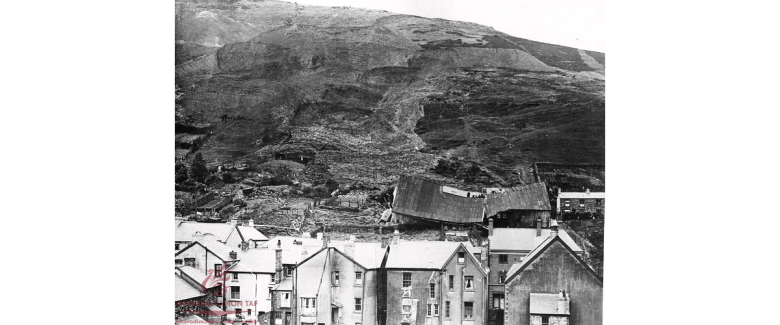
The Landslide Blog is written by Dave Petley, who is widely recognized as a world leader in the study and management of landslides.
Recently, I stumbled across a small gallery of images on the Our Heritage site of Rhondda Cynon Taf that show a major coal waste landslide that struck the South Wales village of Pentre in August 1916. This includes the following image (Figure 1):-
Figure 1: The aftermath of the 1916 coal waste landslide at Pentre in South Wales. Image from Our Heritage at Rhondda Cynon Taf.
On many occasions, I’ve written about the 1966 Aberfan landslide in South Wales, and highlighted the long history of rapid coal waste tip landslides that preceded the disaster. But the 1916 landslide at Pentre was rather different – it was a large but slow failure that impacted the village.
The local history website for Pentre has an article about the 1916 landslide, which also highlights an earlier event (in 1909). The article notes that the landslide just missed Churchfield Row, which allows the location of the landslide to be identified (Figure 2). Churchfield Row is shown in the Google Earth image below, so the landslide site is to the left of it:-
Figure 2: Google Earth image of the site of the 1916 landslide at Pentre in South Wales. The landslide reportedly just missed Churchfield Row, shown in the image.
This puts the landslide at [51.6519, -3.4846]. Just to the west of Churchfield Row, on the other side of the landslide site, is a street called Tip Terrace, which gives a strong indication of the history of the area.
Figure 3 shows the Ordnance Survey map of the area, published in 1921 (i.e. after the landslide) but based on data from 1914 to 1915. Thus, it depicts the site ahead of the landslide:-
Figure 3: The six inch Ordnance Survey map of the site of the Pentre landslide in 1916. Map downloaded from the National Library of Scotland.
Churchfield Row is located by the large “N” in the centre left of the map. Note the Pentre Collieries at the top of the image – this is the source of the coal waste that was being dumped on the slope – and the tramway, which would have been carrying the coal waste to the tipping point. The waste tip itself is shown with stippling and indications of steep slopes.
The Pentre history site article, which is drawn from newspaper reports, notes that the landslide was triggered by heavy rainfall that followed a period of drought. The problem appears to have become acute on 31 August 1916, when extensive cracking was observed on the hillslope, and the mass of debris caused the collapse of a corrugated iron billiard hall. This structure can be seen in Figure 1.
As a consequence of the failure, the houses at the foot of the slope were evacuated, and other buildings (including the branch of a bank, a solicitor’s office and a hotel) were also cleared. The houses were eventually demolished.
Whilst there were no fatalities from the landslide (unlike the 1909 event, in which a child was killed), the failure resulted in a series of court cases in which householders sought compensation for their loss. For example, William Idris and Margaret Gould were awarded £530 (about £38,000 or US$49,000 today). Interestingly, the defence was that the mountain failed, dislodging the coal tip, which was clearly incorrect.
The coal tip that generated the 1916 Pentre landslide is still present, and has been mapped on the Welsh Government directory of coal tips. The lower portion is Category C – “A tip with the potential to impact public safety, to be inspected at least once a year”, whilst the upper portion is Category D – “A tip with the potential to impact public safety, to be inspected at least twice a year”. This is the highest risk class for coal tips in Wales, although there is absolutely no indication of immediate danger at this site, and the risk posed by coal waste landslides in South Wales is now being carefully managed.
Text © 2023. The authors. CC BY-NC-ND 3.0Except where otherwise noted, images are subject to copyright. Any reuse without express permission from the copyright owner is prohibited.
Related
